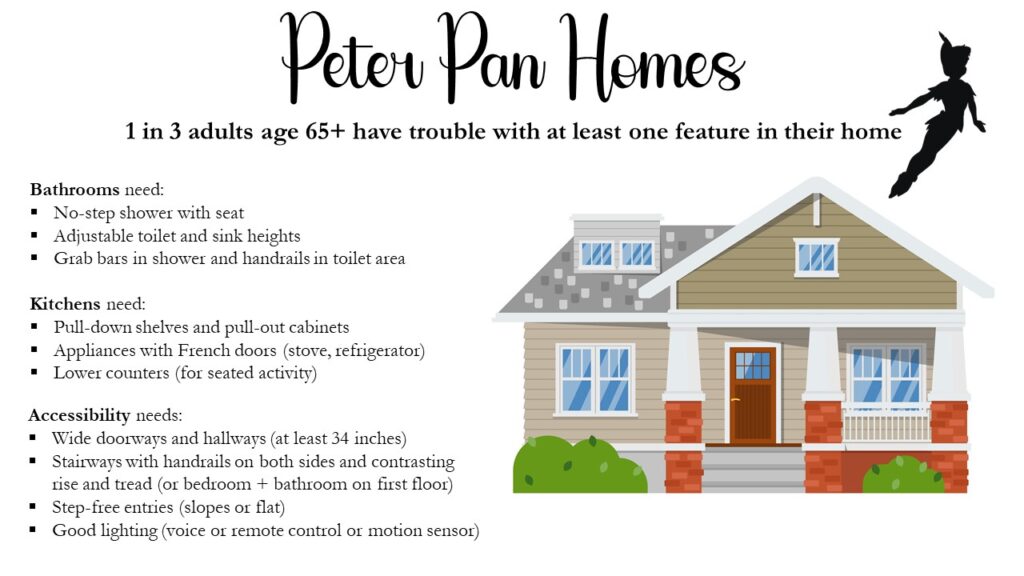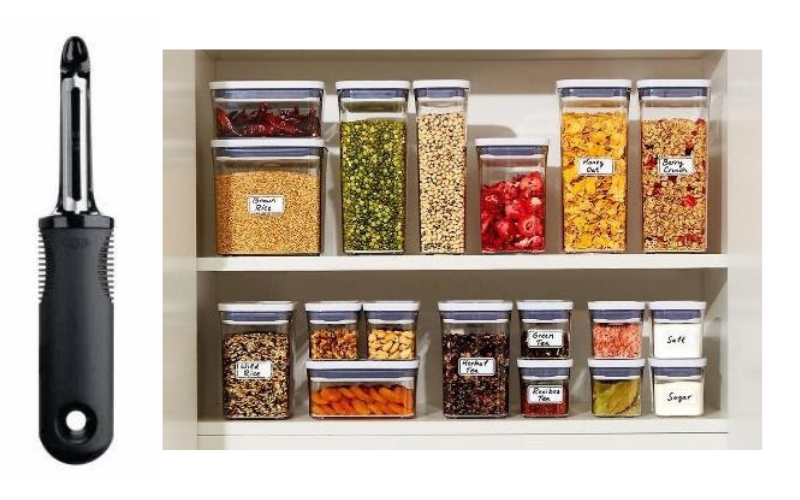As a caregiving expert and influencer, I know the desire to stay in our homes as long and independently as possible, something industry insiders call “aging in place (AiP),” is what 9 in 10 people over age 65 wish. Currently most of the focus on AiP is on health needs – creating accessible, safe environments in the home. But what gets overlooked is the psychological and social aspects of life which help us live longer.
As I was studying for my master’s in gerontology – which is the study of life course aging and finding biopsychosocial balance throughout our lives for better health and longevity – the blending of beauty and design with accessibility and safety became my passion project. I wanted to help people create homes that not only aided them in their health needs but also met their wellness needs.
Americans Live in Peter Pan Housing
According to a Harvard Study, 25% of all U.S. homes have someone who has a physical issue (declining eyesight or hearing; cognitive issues; mobility challenges) that make independent living challenging. Yet less than 3% of all U.S. homes have even three elements of universal design.
Jon Pynoos, PhD., one of my professors at USC Leonard Davis School of Gerontology, called this phenomenon “Peter Pan” housing. In other words, most of the homes built before 2000 are for people who would never grow old. This means we have a gap – people want to stay at home into their 80s, 90s and beyond but their homes need some design magic to make this wish come true.
What is Universal Design?
Back in the 1980s, designers began to think about creating products that could be used by anyone – whether 8-years-old or 80. It was about design that was ageless, accessible, assistive and adaptable. But rather than just another design trend or a design approach for those who had disabilities or who were older, it became a design philosophy focused on better design for everyone – without boundaries of age or ability.
By 1997, the Center for Universal Design at North Carolina State University along with leading architects, engineers, environmental researchers and product designers created seven guiding principles of Universal Design that continue to evangelize ease of use for all.
In 1990 one of the most successful universal design brands was launched: a retired houseware executive created a potato peeler with a rubberized “fins grip” to help his wife continue to cook despite her arthritis. The rest is history. Today, OXO Good Grips has more than 1,000 products including my favorite organization tool for kitchen, bath and office: Pop containers.
Design Your Home and Life Using Proven Science in Happiness
Many universal design ideas that you will find in my blogs can be started at any age. Again, this is an age-agnostic concept. And yet, many people wait until there is a medical emergency or family crisis, when emotions are fraught and no one has time to research anything. These designs make life easier now regardless of need. And, if you start now, then when you do need it, it will be there waiting for you.
Universal design upgrades also make sense financially. By using our Design for Life Home Checklist, you can and should make upgrades and changes to your home in your 30s, 40s and 50s that will make it livable into your 90s. It not only spreads out the cost over decades instead of having to get it done in one weekend, but it actually adds value to your home’s resale potential. Our Design for Life Plan gives you room by room checklists to help make universal design an ongoing part of your home design dreams.
Behavioral science has shown that by doing small things more frequently, your happiness quotient increases dramatically. It is the same psychological concept I used in my Me Time Monday wellness program: small steps (using prompts), a frequent, repetitive schedule and rewarding and celebrating your success – happiness is in your hands!
Waving the White Flag on Aging
Getting older is a highly misunderstood phenomenon despite the fact that every single person on the planet is experiencing it. Our society currently sees older age as an era that means disease, decay, decline, depression. Let’s do away with these “D” words – those are ageist perceptions that have been debunked (another “D” word for you). Older adults still have dreams and desires for our homes to be beautiful as well as practical every decade after 50. After all, 50 is the becoming the new 35 – science shows that 50% of 10-year-olds today will live to 104.
I admit, our bodies do start a little revolt as we age. We reach for the eye creams, jump on a treadmill or pedal our fitness bikes and drink kombucha (a trendy way of saying, “tea fungus.”). We have a “take no prisoners” approach to our physical bodies but what about our physical spaces? Does our dream home love us back after 50? It can but like any good relationship, we have to give to get. So let’s call a truce on the war against aging. Let’s wave the white flag and instead embrace the possibilities the last 30 years of life gives us.
In the movie “Field of Dreams,” the voice whispered, “If you build it, they will come.” I think we need to create our forever dream homes by whispering to ourselves, ”If you design it now, you will stay.”
And that is what The Snug Home is all about. How to do the things you love, live in a home that loves you back, and go to cozy, cool places you have always dreamed about (even if it is virtually). We may be helping our parents embrace these new universal designs or maybe we’re planning ahead in our own homes. But one thing is certain: we are all aging. So don’t be in denial, be a doer. Life’s journey brings mystery, magic and meaning – don’t miss a minute of it. Design your ageless dream home today.
We hope you enjoy The Snug Home!





0 Comments